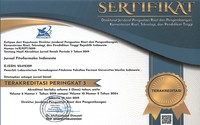The Effect of Extraction Method on Catechin Levels in Green Tea (Camellia sinensis L.) Extract by TLC-Densitometric
Abstract
Green tea (Camellia sinensis L.) is one of the most widely used plants in Indonesia. Green tea (Camellia sinensis L.) is rich in catechins which have many benefits including antioxidants, anticancer, can reduce stress, and reduce cholesterol levels in the blood. This study aims to determine the levels of catechins in Green Tea (Camellia sinensis L.) extract with various extraction methods. Each sample was extracted by maceration, microwave and infusion using aquadest solvent and the extract obtained in Freeze Drying. Qualitative analysis using 1% FeCl3 reagent, positive catechins are indicated by a color change to blackish blue and quantitative analysis using TLC-Densitometry. The results showed the catechin content of the extract by maceration method was 331 mg/g
Keywords
Full Text:
PDFReferences
Alamsyah, NA, 2006, Conquer Disease with Green Tea, Agrimedia Pustaka Publisher, Jakarta.
Akroum, S., Satta, D., Lalaoui, K., 2009, Antimicrobial, Antioxidant, Cytotoxic Activities and Phytochemical Screening of Some Algerian Plants, Eur. J. of Scientific, Research, 31(2):289-295.
Delazar, Abbas, Lutfun Nahar, Sanaz, H., Satyajit, D., Sarker, 2012. Microwave-Assisted Extraction in Natural Products Isolation, Dalam Satyajit D. Sarker and Lutfun Nahar (eds.), Natural Products Isolation, Methods in Molecular Biology, vol 864, Springer Science: New York.
Directorate General of Drug and Food Control, 2000. General Standard Parameters for Medicinal Plant Extracts, Ministry of Health, Republic of Indonesia: Jakarta.
Directorate General of POM, 1986, Galenic preparations, Ministry of Health, Jakarta.
Gritter, Roy J., Bobbit JM, and Schwarting AE, 1991, Introduction to Chromatography, 2nd Edition, ITB Publisher, Bandung.
Harborne JB, 1987, Phytochemical Methods Guiding Modern Ways to Analyze Plants, ITB Publisher, Bandung.
Hanani E., and Mun'in A., 2011, Basic Phytotherapy, Dian Rakyat, Jakarta, Indonesia.
Integrated Taxonomic Information System, 2015,Camellia sinensis,www.itis.gov, Downloaded 02 September 2015.
Husain, M., Lutfi, M., Hendrawan, Y., 2014, Journal of Analysis of the Effect of Microwave Essisted Extraction (MAE), Vol. 2 (2): 147-155.
Kerem, Z. 2005, Microwave Assisted Extraction of Saponins, J, Food Science.
Kurniawan, 2014, Comparative Study Of HPTLC Fingerprint Of ASorene Content between Leaves and Rhizome Of Acorus Calamus L, Faculty of Pharmacy, Indonesian Muslim University, Makassar.
Manning, J., Roberts, JC, 2003, Analysis of catechin content of commercial green tea product J Herb Pharmacother, 3:19-32.
Martono, S., Martono, Y., 2012, High performance Liquid Chromatography Analysis for Determination of Gallic Acid, Caffeine, and Epigallocatechin Gallate Concentration in Various Tea Bags Product, Vol. 32 (4).
Mukhtar, H. And Ahmad, N., 1999, Green Tea in Chemiprevention of Cancer, Toxicol Scie, 52:111-117.
Munson, JW 1991. Modern Pharmaceutical Analysis Methods. Surabaya: Airlangga University.
Moh, Anief, 2003, The Science of Mixing Medicine, Yogyakarta, Gadjah Mada University Press, pp. 167-82.
Robinson, T., 1995, Organic Content of Higher Plants, ITB, Bandung.
Rohman, 2007, Pharmaceutical Chemical Analysis, Student Library, Yogyakarta.
Schunack, W., 1990, Pharmaceutical Chemistry Textbook Edition 2, Gajah Mada University, Yogyakarta.
Sherma, J., 1994, Handbook of Thin Layer Chromatography Third Edition, Marcel Dekker Inc., New York.
Soraya, N, 2007, Health and Beauty Thanks to Green Tea, Self-Help Disseminator, Jakarta.
Stahl, E., 1985, Chromatographic and Microscopic Drug Analysis, Translated by Kosasih Padmawinata and Iwang Soediro, ITB Publisher, Bandung.
Sudarmadji, S., and Suhardi, 2007, Procedures for Analysis of Foodstuffs and Agriculture, Yogyakarta, Liberty.
Sumarno, 2002, Chromatography Theory and Practical Instructions, Division of Pharmaceutical Chemistry, Faculty of Pharmacy, Gadja Mada University, Jogjakarta.
Sugihartini, N., Fudholi, A., & Pramono, S, 2012, Analytical method of assay of epigallocatechin error by TLC- Densitometry, Pharmaceutical scientific journal, 2 (1): 81-87.
Widyaningrum, N., 2007, Variations in Concentration of Ethanolic Extract of Green Tea Leaves (Camelia Sinensis L.) in Cream Preparations on Physical Properties and Antibacterial Activities, Thesis, Faculty of Pharmacy, Wahid Hasyim University, Semarang.
Yuangsoi, B., Jintasataporn, O., Areechon, N and Tabthipwon, P., 2008, Validated TLC-Densitometric analysis for determination of carotenoids in fancy carp
DOI: https://doi.org/10.33096/jffi.v9i3.915
Copyright (c) 2022 Aktsar Roskiana Ahmad

This work is licensed under a Creative Commons Attribution-ShareAlike 4.0 International License.
Indexed by:
ISSN: 2356-0398 | e-ISSN: 2541-2329
Editor's Address:
Third Floor Pharmacognosy-phytochemistry laboratory building, Urip Sumoharjo road km. 5 Campus II UMI, Makassar, South Sulawesi, Indonesia
Phone: +6281524045514
Fax: +62411425619
E-mail: editorjfi@umi.ac.id

















.jpg)

